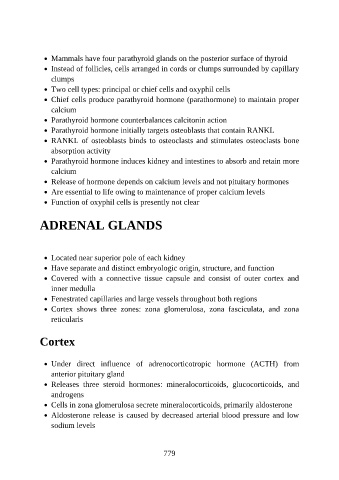Page 780 - Atlas of Histology with Functional Correlations
P. 780
Mammals have four parathyroid glands on the posterior surface of thyroid
Instead of follicles, cells arranged in cords or clumps surrounded by capillary
clumps
Two cell types: principal or chief cells and oxyphil cells
Chief cells produce parathyroid hormone (parathormone) to maintain proper
calcium
Parathyroid hormone counterbalances calcitonin action
Parathyroid hormone initially targets osteoblasts that contain RANKL
RANKL of osteoblasts binds to osteoclasts and stimulates osteoclasts bone
absorption activity
Parathyroid hormone induces kidney and intestines to absorb and retain more
calcium
Release of hormone depends on calcium levels and not pituitary hormones
Are essential to life owing to maintenance of proper calcium levels
Function of oxyphil cells is presently not clear
ADRENAL GLANDS
Located near superior pole of each kidney
Have separate and distinct embryologic origin, structure, and function
Covered with a connective tissue capsule and consist of outer cortex and
inner medulla
Fenestrated capillaries and large vessels throughout both regions
Cortex shows three zones: zona glomerulosa, zona fasciculata, and zona
reticularis
Cortex
Under direct influence of adrenocorticotropic hormone (ACTH) from
anterior pituitary gland
Releases three steroid hormones: mineralocorticoids, glucocorticoids, and
androgens
Cells in zona glomerulosa secrete mineralocorticoids, primarily aldosterone
Aldosterone release is caused by decreased arterial blood pressure and low
sodium levels
779

